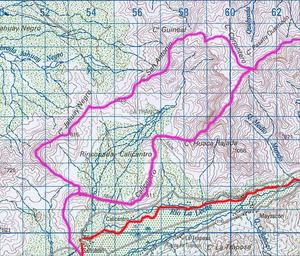|
[Features] |
PROCEDURES
The model consists of six components: (1) network topology, (2) precipitation, (3) hydrologic abstraction, (4) rainfall-runoff transform, (5) channel routing, and (6) channel abstraction.
The network topology is the RAINFLO© topology, where the basin/channel network is specified as an array of [order-branch-reach] topological numbers. The model distinguishes between upland and reach watersheds [subbasins]. Upland watersheds do not have tributary flow; reach watersheds have tributary flow from either one upland or two reach watersheds.
Precipitation is specified as 24-hour duration rainfall depth for the chosen frequency [or return period]. The rainfall depth is a constant for each individual watershed, and can vary from watershed to watershed. NRCS storm types are used to develop hyetographs for the subbasin storms. The default storm type is I.
The hydrologic abstraction is made with the NRCS runoff curve number. Three antecedent moisture conditions (AMC) can be specified: either I, II or III. The default AMC is II.
For each watershed, the unit hydrograph is calculated following NRCS practice, and the effective rainfall hyetograph is convoluted with the unit hydrograph to develop the flood hydrograph.
Following the network topology, the flood hydrographs are combined seamlessly in time and space, and routed downstream using the Muskingum-Cunge method. Reach subdivision is implemented to keep the subreach Courant number as close to 1 as practicable, assuring the accuracy of the computational procedure.
The input consists of six types of data: (1) name and units, (2) topology, (3) selections, (4) upland watershed hydrologic data, (5) reach watershed hydrologic data, and (6) reach watershed hydraulic data.
